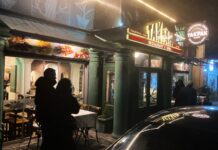If you ask me, nothing pertaining to autumn as a season should be fair game for touts until Labor Day has come and gone. As a “beer guy” of long standing, mid-September and Oktoberfest will always be synonymous with the best in seasonal beer drinking – and here’s why.
In terms of ideal weather, the Ohio Valley’s heat and stickiness isn’t always ideal for conjuring the autumn conditions best calculated to enjoy the style of lager beer known as Oktoberfest (or Märzen).
Moreover, American beer marketing prerequisites as determined by folks far above my pay grade have conspired to place Oktoberfest beers on store shelves six to eight weeks before that perfect day when at last the air is crisp and clean, leaves begin turning and an indefinable craving for bratwurst can’t be shaken.
Still, it can be wonderful to enjoy seasonal beers in their appropriate season, especially when they’re well-crafted lagers.
Oktoberfest always was misleading to American ears, this being a “German” concept confined largely to Bavaria and its capital, Munich, and for reasons of history beginning in September, not October.
Back in the 1980s in metro Louisville, when we first began receiving shipments of Oktoberfest beer from Bavarian breweries, these tended to be malty amber or brown-shaded lagers. Subsequently they’ve tended to lighten in color, while always remaining malt forward, impeccably balanced and of slightly higher alcoholic strength than the norm.
I’ve never been able to separate Oktoberfest beers from two primary influences.
The first was the late Michael “The Beer Hunter” Jackson’s vivid descriptions of Oktoberfest in his books, both as a festival and as a seasonal beer, and the second was finally being there in Munich in 1989 to witness one and drink the other.
Kindly indulge a look back.
—
In September of 1989, after an eventful summer spent chasing history in the East Bloc, the leaves were beginning to turn in Copenhagen when it was time for the rail journey to Munich. I’d never been to Oktoberfest, and meant to redress this oversight.
We stocked up on beer, salami, beer, cheese, beer, bread and more beer before boarding for the overnight journey to the Bavarian capital, where reservations had been made at the Pension Hungaria, a small, inexpensive family-run guesthouse near the Hauptbahnhof, or central train station.
Upon arrival, it was still morning. We hurried down the platform to the famous Imbiss at the foot of Gleis (track) 16. The Imbiss is long gone, victim of extensive remodeling, modernization and gentrification, and it wasn’t all that much even in its heyday, but during the 1980’s this simple, functional train station concession stand was a genuine Munich destination for budget travelers the world over.
There were two long windows with outside counter space, plentiful tile and stainless steel, wonderful beer taps, kitchen equipment for preparing basic snacks and several customarily greasy, though by necessity efficient, employees in blue smocks.
In front of the Imbiss were a handful of tables that resembled smaller, elongated versions of the telephone wire spools that used to litter backyards in the Georgetown of my youth. Standing at the tables in morning, evening and night were locals, tourists, commuters, vagrants and assorted hangers-on, the majority of them savoring the Imbiss’s only true specialties: Cool Hacker-Pschorr golden lager at a reasonable price and a portion of Leberkäse, a high-quality form of all-meat bologna cut from a warm deli-sized square loaf, weighed and priced, and served with a crusty roll and plenty of mustard.
The Imbiss at Gleis 16 never disappointed, and with breakfast under our belts, it was time to claim the room and prepare for the main event: Oktoberfest, 1989. A few hours later, unburdened of luggage, with Deutschmarks in hand and harboring a powerful thirst, a vast fairgrounds lay before me. It was crowded with carnival rides, arcades, food vendors of every stripe and giant prefabricated beer halls.
There was at least one Oktoberfest beer hall for each of Munich’s six major breweries, all having every appearance of being permanent structures, and yet they would be completely dismantled and stored away at the end of the two-week festival.
Thousands of people of all colors, creeds and nationalities were spread out before me, reveling in Bavaria’s most notorious celebration of beer as a beverage, as a foodstuff and as a way of daily life. My favorites were the natives dressed in folkloric Dirndls and Lederhosen.
I’d come to the grounds by way of the U-Bahn (subway), where scores of policemen assisted in the packing and unpacking of underground trains at a station built overly large for peak usage during Oktoberfest’s annual run.
Emerging into the cool dampness, I plunged into the throng and was carried through the Midway by the crowd, past bumper car arenas and target-shooting booths that wouldn’t be out of place at an American state fair, and toward beer halls that assuredly would.
Soon the mass of people parted in near Biblical fashion to reveal the majesty of the Paulaner hall. Gaping at the vision before me, I went off-tackle and bulled ahead. From fifty yards away, the interior was visible through several sets of opened double doors; trance-like, my eyes focused on the octagonal bandstand in the center, where an oom-pah orchestra twice the size of any I’d seen before held forth to the undisguised delight of hundreds of glass-wielding drinkers.
The temporary structure seemed to shake and roll, and to no surprise: Half the people inside were dancing and singing atop the heavy wooden tables, tables that surely had been constructed with precisely that sort of punishment in mind. Obviously, considerations of decorum — those restraints on behavior customarily observed by polite society — had been temporarily forgotten, to the obvious edification of all those present.
I stopped at one of the outer doors. Just yards away, absurdly long rows of whole chickens were being roasted on spits. Signs decreed the price of the liter-sized Masses to be a sum of now obsolete Deutschmarks; I can’t remember exactly how many, although the exchange rate probably had them pegged at around $7 or $8 for 33.8 ounces.
Just like in the photos, matronly waitresses toting anywhere from two to ten of the deliciously full Masses rushed past. Pretzels the size of large plates were being eaten.
Still standing at the door, I beheld this veritable city of beer, and as I started to enter, a greenish-hued man staggered past me and began vomiting violently next to a steel support beam.
Finally, it seemed that I’d found home.
Im Himmel gibt es kein bier! Darum trinken wir es hier!
Fifteen years later, I made it to Munich’s Oktoberfest a second time. We convened midweek at midday and found ourselves surrounded by hundreds of Germans with nary a tourist in sight. They’d come to eat (and drink) lunch before returning to work, and the scene seemed weirdly normal compared with the typical nighttime revelry.
Perhaps someday the chance will come for me to experience the original Munich fest again, but maybe not. While nothing can match the memory of the first time, and Oktoberfest in Munich is something everyone should try to do at least once, it’s even better to board a train for the countryside, find a weekend harvest celebration in a small town, and be immersed in seasonal beers and atmospheres. There might not be an app or a website for those lesser known venues; we can only hope.
Barring this, look to your Louisville-area breweries, bars and restaurants for Oktoberfest beer tasting opportunities, and let the daily weather report be your guide.


























